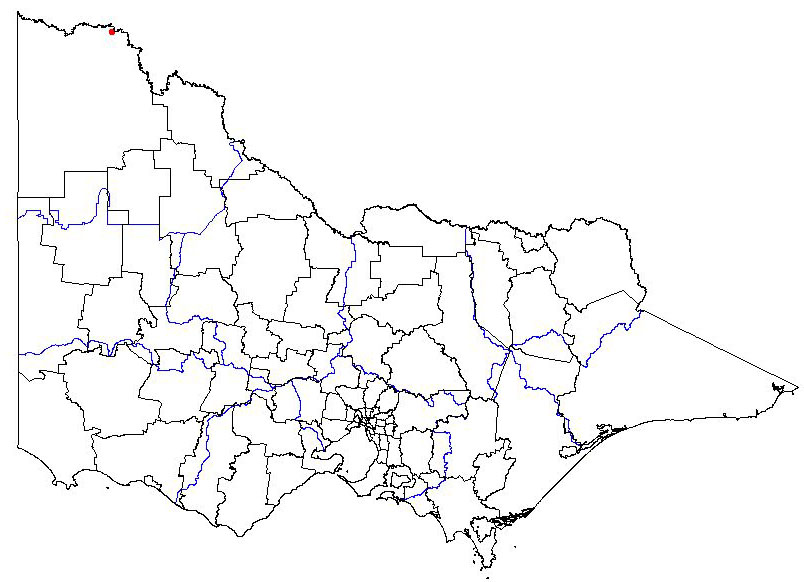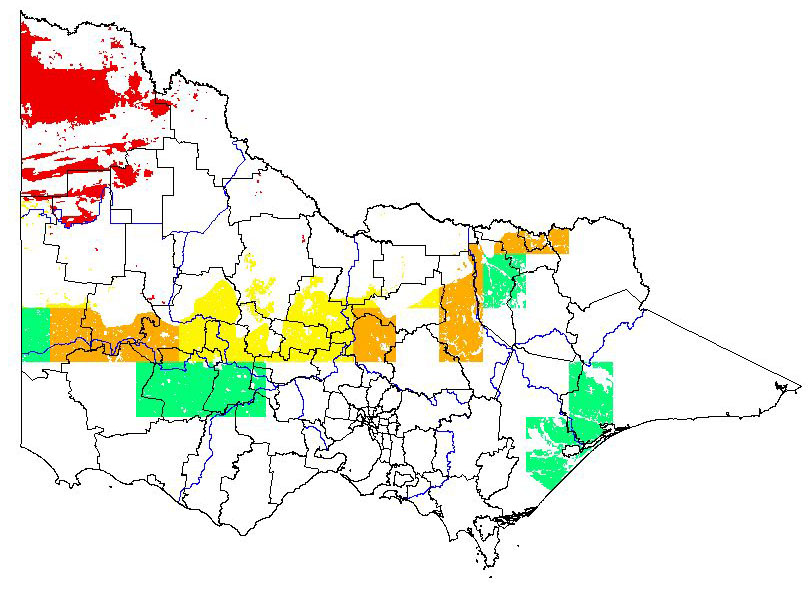Lindheimer Prickly Pear (Opuntia lindheimeri)
Present distribution
|  Map showing the present distribution of this weed. | ||||
| Habitat: Native to North America. Reported in Grassland and desert including at elevation. | |||||
Potential distribution
Potential distribution produced from CLIMATE modelling refined by applying suitable landuse and vegetation type overlays with CMA boundaries
| Map Overlays Used Land Use: Pasture dryland Broad vegetation types Coastal scrubs and grassland; coastal grassy woodland; heathy woodland; box ironbark forest; inland slopes and plains; sedge rich woodland; dry foothills forest; montane dry woodland; sub-alpine woodland; grassland; plains grassy woodland; herb-rich woodland; sub-alpine grassy woodland; montane grassy woodland; rainshadow woodland; mallee; boinka-raak; ; mallee woodland; wimmera / mallee woodland Colours indicate possibility of Opuntia lindheimeri infesting these areas. In the non-coloured areas the plant is unlikely to establish as the climate, soil or landuse is not presently suitable. | 
|
Impact
QUESTION | COMMENTS | RATING | CONFIDENCE |
| Social | |||
| 1. Restrict human access? | Can form large thickets and spines would hinder clearance (Benson 1982). | mh | m |
| 2. Reduce tourism? | Probable negative influence of aesthetics. | ml | ml |
| 3. Injurious to people? | Does have spines (Benson 1982). | mh | m |
| 4. Damage to cultural sites? | No structural damage reported may have a negative influence on aesthetics. | ml | ml |
| Abiotic | |||
| 5. Impact flow? | Terrestrial species | l | m |
| 6. Impact water quality? | Terrestrial species | l | m |
| 7. Increase soil erosion? | I has been reported a spiny cactus species can prevent up to 50% of the herbage cover immediately surrounding it being removed by grazing pressure, therefore limiting over grazing, therefore maintaining ground cover and reducing soil exposure (Mueller, Shoop & Laycock 1994). | l | m |
| 8. Reduce biomass? | Invading grassland, would cause an increase in biomass, also if grazing pressure is restricted there would be a net increase in biomass (Mueller, Shoop & Laycock 1994). | l | m |
| 9. Change fire regime? | Due to high water content cacti species do not easily burn themselves, however if the presence of O. lindheimeri does maintain a higher grass biomass by restricting grazing, this would increase the fuel load of the area (Mueller, Shoop & Laycock 1994). | m | m |
| Community Habitat | |||
| 10. Impact on composition (a) high value EVC | EVC= Plains Savannah (E); CMA= Mallee; Bioreg= Lowan Mallee; VH CLIMATE potential. Competitive in the shrub layer and alters species composition of ground layer. Major displacement of species. | mh | mh |
| (b) medium value EVC | EVC= Semi-arid Woodland (D); CMA= Mallee; Bioreg= Lowan Mallee; VH CLIMATE potential. Competitive in the shrub layer and alters species composition of ground layer. Major displacement of species. | mh | mh |
| (c) low value EVC | EVC= Red Swale Mallee (LC); CMA= Mallee; Bioreg= Lowan Mallee; VH CLIMATE potential. Competitive in the shrub layer and alters species composition of ground layer. Major displacement of species. | mh | mh |
| 11. Impact on structure? | Invading grassland it creates a shrub layer, also by altering grazing pressure and potentially fire regimes may alter grass/herb composition. | ml | m |
| 12. Effect on threatened flora? | No specific data, however they are noted for protecting species sensitive of grazing. | m | ml |
| Fauna | |||
| 13. Effect on threatened fauna? | No Australian data, found to be an important food source for desert big horn sheep and white-tailed deer in native range (Arnold & Drawe 1979). | m | m |
| 14. Effect on non-threatened fauna? | In grassland its presence adds a layer that previously didn't exist, while not having a major impact on the grass/herb layer. | l | m |
| 15. Benefits fauna? | Has been seen as an important alternate food source in its native range, especially during the dry season (Arnold & Drawe 1979). | ml | m |
| 16. Injurious to fauna? | Does have spines (Benson 1982). | mh | m |
| Pest Animal | |||
| 17. Food source to pests? | Eaten by goats (Ramirez, Haenlein & Nunez-Gonzalez 2001). | ml | m |
| 18. Provides harbor? | No specific data, may provide shelter in a grassland where there previously wasn't any. | m | m |
| Agriculture | |||
| 19. Impact yield? | Can invade grassland and reduce net grazing area (Benson 1982), however in a rangeland situation also seen as an additional fodder source (Mueller, Shoop & Laycock 1994, Potter, Peterson & Ueckert 1984 and Ramirez etal 2000). | ml | mh |
| 20. Impact quality? | Small reduction in quantity of fodder may have ill effect on stock, however a high water content feed during dry times may be beneficial (Ramirez etal 2000). | l | m |
| 21. Affect land value? | If control viewed as necessary may have negative impact on land value. | m | l |
| 22. Change land use? | May reduce stocking rates but wouldn't alter system from grazing. | l | ml |
| 23. Increase harvest costs? | If restrict the movement of stock may increase mustering times. | mh | m |
| 24. Disease host/vector? | No specific data. | l | m |
Invasive
QUESTION | COMMENTS | RATING | CONFIDENCE |
| Establishment | |||
| 1. Germination requirements? | In their natural range, germination occurs during the summer rainy season, requiring 43mm or more of rain in 2 weeks or less (Bowers 2005). Vegetative growth can also occur from a broken segment (Benson 1982). | h | mh |
| 2. Establishment requirements? | Reported to inhabit grassland and brushlands (Benson 1982), establishment of seedlings infrequent requiring sufficient water over a period of time plains. Journal of Range Management. 32: 175-178. (Bowers 2005). | mh | m |
| 3. How much disturbance is required? | Reported in grasslands (Benson 1982). | mh | m |
| Growth/Competitive | |||
| 4. Life form? | Shrubby cactus (Benson 1982). | l | mh |
| 5. Allelopathic properties? | None described. | l | m |
| 6. Tolerates herb pressure? | Has spines but is reportadly eaten, by big horn sheep, goats, white-tailed deer and cattle (Arnold & Drawe 1979, Ramirez, Haenlein & Nunez-Gonzalez 2001 and Tarango etal 2002). Short term intensive grazing can increase the population by breaking segments but not consuming them allowing for increased vegetative dispersal (Taylor & Merrill 1975). | ml | m |
| 7. Normal growth rate? | Time to reproductive maturity from seed has been reported to be between 9-11 years, it may be faster from vegetative growth however this is slow in comparison to other cactus species (Bowers 2005). | ml | m |
| 8. Stress tolerance to frost, drought, w/logg, sal. etc? | Desert Cactus (Drought tolerant) (Bowers 2005). A single burn in Arizona killed 25% in a population, fire is also used a a way of de-thorning cactus so that it will be more readily eaten by cattle (Reynolds & Bohning 1956). Described as cold hardy and used as a hybrid parent to increase frost tolerance in other opuntia species (Wang, Felker & Paterson 1997). | mh | m |
| Reproduction | |||
| 9. Reproductive system | Produces seed, and can spread vegetatively from broken segments (Bowers 2005). | h | mh |
| 10. Number of propagules produced? | Is in cultivation for its fruit crop, fruit contain numerous seeds (Benson 1982). | h | m |
| 11. Propagule longevity? | Seeds can persist in the soil for at least 19 months and potentially longer (Bowers 2005). | l | m |
| 12. Reproductive period? | Individuals can live up to 30 years, while it takes 9-11 years to reach reproductive maturity from seed, plants can spread vegetatively during this time (Bowers 2005). | h | h |
| 13. Time to reproductive maturity? | From seed plants take 9-11 years to reach reproductive maturity, however from vegetative dispersal faster growth rates have been recorded and may produce more vegetative propagules within a year (Bowers 2005). | h | m |
| Dispersal | |||
| 14. Number of mechanisms? | Fruit produced which have been noted to be eaten by a number of animal species (Mosallum 1996 and Potter, Peterson & Ueckert 1984). | mh | m |
| 15. How far do they disperse? | If fruits eaten by cattle may be seeds may be dispersed kilometres (Potter, Peterson & Ueckert 1984). | h | mh |
References
Arnold. L.A. Jr. & Drawe. D.L. (1979) Seasonal food habits of white-tailed deer in the south Texas plains. Journal of Range Management. 32: 175-178.
Benson. L. (1982) The Cacti of the United States and Canada. Stanford University press, Stanford, California.
Bowers. J.E. (2005) Influence of climatic variability on local population dynamics of Sonoran Desert platyopuntia. Journal of Arid Environments. 61: 193-210.
Mosallum. H.A.M. (1996) Germination ecology of seeds extracted from baboon faeces in Al Hada, Taif, Saudi Arabia. Desert Institute Bulletin. 46: 387-408.
Mueller. D.M., Shoop. M.C. & Laycock. W.A. (1994) Mechanical harvesting of plains pricklypear for controll and feeding. Journal of range management. 47: 251-254.
Potter. R.L., Peterson. J.L. & Ueckert. D.N.(1984) Germination responses of Opuntia spp. to temperature, scarification, and other seed treatments. Weed Science. 32: 106-110
Ramirez. R.G., Haenlein. G.F.W. & Nunez-Gonzalez. M.A. (2001) seasonal variation of macro and trace mineral contents in 14 browse species that grow in northeastern Mexico. Small Ruminant Research. 39: 153-159.
Taylor. C.A. & Merrill. L.B. (1975) Influence of a short-duration grazing system on pricklypear. Rangland Resources Research: Consolidation Progress Report 1971-74. 9-10
Tarango. L.A., Krausman. P.R., Valdez. R. & Kattnig. R.M. (2002) Research observation : desert bighorn sheep diets in northwestern Sonora, Mexico. Journal of Range Management. 55: 530-534.
Wang. X., Felker. P. & Paterson. A. (1997) Environmental influences on cactus pear fruit yield, quality and cold hardiness and development of hybrids with improved cold hardiness. Journal of the Professional Association for Cactus Development. 2: 48-59.
Global present distribution data references
Australian National Herbarium (ANH) 2006, Australia’s Virtual Herbarium, Australian National Herbarium, Centre for Plant Diversity and Research, viewed Aug 29 2006, http://www.anbg.gov.au/avh/
Bowers. J.E. (2005) Influence of climatic variability on local population dynamics of Sonoran Desert platyopuntia. Journal of Arid Environments. 61: 193-210.
Global Biodiversity Information Facility (GBIF) 2006, Global biodiversity information facility: Prototype data portal, viewed Aug 29 2006, http://www.gbif.org/
Missouri Botanical Gardens (MBG) 2006, w3TROPICOS, Missouri Botanical Gardens Database, viewed Aug 29 2006, http://mobot.mobot.org/W3T/Search/vast.html
Feedback
Do you have additional information about this plant that will improve the quality of the assessment?
If so, we would value your contribution. Click on the link to go to the feedback form.


